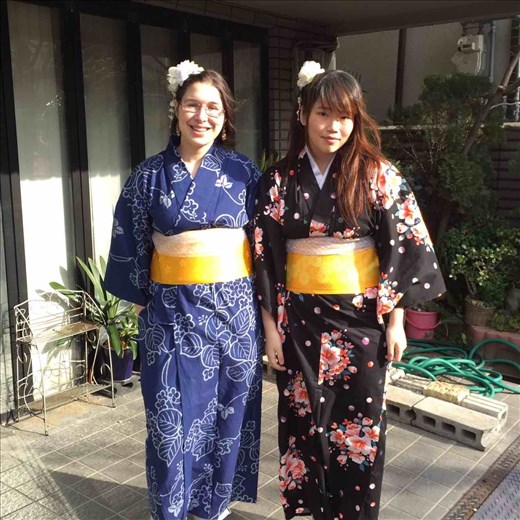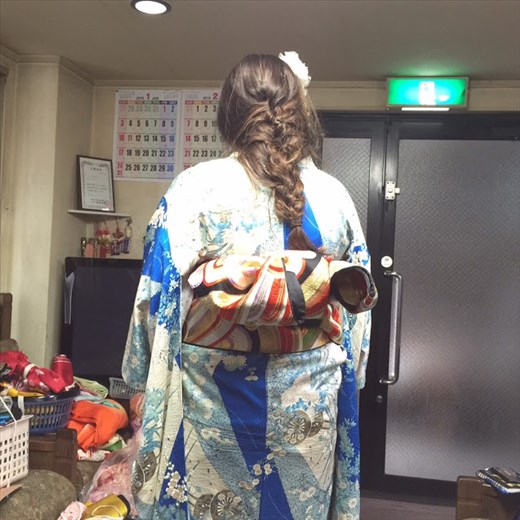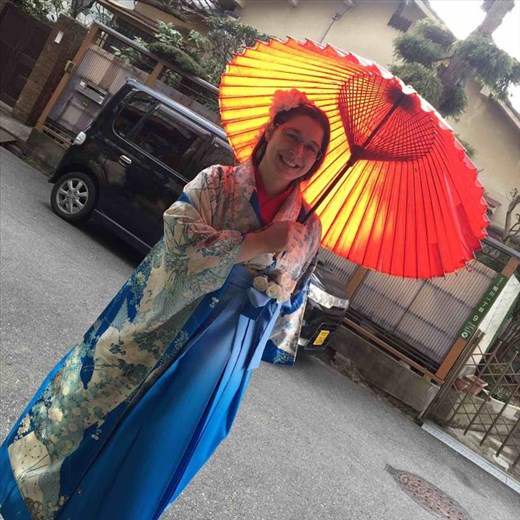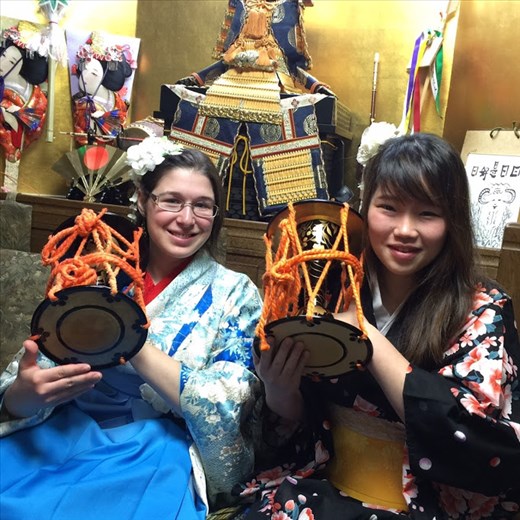During orientation, they stressed several times that we should be checking our e-mails. That they would try and post signs on doors about important events, but we should be checking our e-mails to make sure we didn’t miss things. Naively, and as a girl who has basically never known life without e-mail, I assumed that this meant that information would be conveyed through e-mail, and not merely through signs on classroom doors. (The last time I needed to check a set of doors for new information was before starting fifth grade when I wanted to see what class I was in. Since then, signs on doors have always been supplementary reminders.)
As such, although I kind of noticed that there were signs out giving more information about the kimono wearing event planned, I didn’t pay that much attention. So I was surprised on Sunday to receive a message “Where are you? Come to Aikawa station!”
Where I was when I received this message was Umeda. So I had to run to find a line that connected to Aikawa, still trying to text in Japanese to figure out what was going on, get on a train going in the right direction, and ride for about fifteen minutes to get there. The first step turned out to be remarkably simple, since I was at a station for the line that went to Aikawa. Which is good, since if I’d needed to wander past more trains, I almost certainly would have gotten on the wrong one.
Mayuka was waiting for me at the station, though the other girls from my apartment had moved on. As we arrived, they were already finishing up and leaving, so it was just Mayuka and I. This had the disadvantage of meaning I wasn’t included in the group pictures, but the net advantage that it meant I had way more attention and help with the yukata and kimono then I would have had otherwise. (Also: the time between me getting the “where are you?” text and arriving at the Ariyama-san’s was 35 minutes. The time between me arriving there and leaving was 45 minutes. I’m not quite sure how that worked.)

The first thing I did was choose a yukata. I’d tried on a yukata several times before: the first time I was in Japan, first semester sophomore year with my Japanese class, and then again second semester as part of the speech and performance contest. So that was not a new experience.
Yukata is a specific type of kimono, most generally associated with summer. It is a good deal lighter than a full kimono, and also much less expensive. It’s also easier to get on, especially when you cheat and have a pre-tied bow that you just need to hook onto the obi (belt).

The new experience for the day (other than finding my way back from the Umeda train station very quickly) was putting on a kimono. Due to the cost, both financial and time-wise, of a full kimono, they tend to be reserved for special occasions. And that’s where it was really nice to have two Japanese women fussing at me so all I needed to do was raise and lower my arms.
Even with that, my arms were getting pretty heavy by the end. Kimonos areheavy. The sleeves go practically to the floor, and even though I think they’re made out of silk, (it felt like silk) that’s still a lot to be carrying around on one’s arms. (I believe that the sleeves of the kimono can be used as pockets. It’s more modest than a bra, and like most women’s formal clothing, real pockets don’t exist.)

Wearing the kimono felt for me about as comfortable as putting on a Western-style formal dress does. Which, at face value, means not comfortable at all. You need to fight to keep your sleeves off the ground, (not a problem I can say I’ve ever had before today) there are about six different belts around your waist, you can’t walk quickly, and I lost track of how many layers and pieces of fabric they put on me. It’s not the sort of thing I’d voluntarily wear out to a full day of classes. But at the same time, although it doesn’t feel natural, it feels nice. The materials and craftsmanship on the kimono are excellent, and, especially when several Japanese women are cooing over how pretty it is/you are (subject are often omitted from Japanese, so there can be a lot of ambiguity about who of what is being described as pretty), wearing it can be an incredibly pleasant experience.
With the kimonos still on, Mayuka and I got a crash course in playing a traditional Japanese drum (drum is a pretty obvious choice for that, because even if you’re not playing it completely correctly, producing a sound is much easier than it is with most other types of instruments) until the next group showed up, at which point we changed back and left.

The lessons from the day are two-fold. First, I should pretend that I’m in elementary school and still find signs posted on the doors extremely exciting. (This has been tampered by a considerable degree by years of dorm living, where the only things they post on the doors are mandatory meeting announcements.) The second is that no one knows color selection like Japanese women selecting an obi to go with a kimono or yukata. Because every time you choose a base color, they will pull out an obi that doesn’t seem to match to go with it. And, even if you’re an art student, you’ll kind of look at them and go “are you sure?” And every time, they’ll be right.